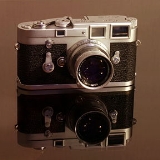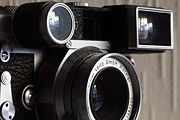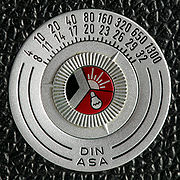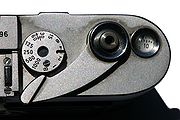
Leica M3
Encyclopedia
The Leica M3 is a 35 mm rangefinder camera
by Leica AG, introduced in 1954. It was a new starting point for Leitz, which until then had only produced screw-mount Leica cameras that were incremental improvements to its original Leica (Ur-Leica). The M3 introduced several features to the Leica, among them the combination of viewfinder and rangefinder in one bright window, like on the Contax II
, and a bayonet lens mount. It was the most successful model of the M series, with over 220,000 units sold by the time production of the M3 model ended in 1966.
It was succeeded by a number of later M series cameras, including the M7
film camera which is still in production today.
. Lenses are changed faster than with a screw mount, and framelines set automatically. Non-Leitz/Leica bayonet-mount lenses can also be used (although none were produced in any quantity while the M3 was sold), and a simple adapter also allows the use of screwmount lenses (whether from Leitz or other companies).
 It was the first Leica to combine rangefinder and viewfinder into one window. (Other cameras, such as the Contax II
It was the first Leica to combine rangefinder and viewfinder into one window. (Other cameras, such as the Contax II
, already had this feature before World War II
; and other companies were making screwmount bodies with combined finders.) Framelines for 50, 90 and 135mm are shown, although none for any wider lenses. However, Leica solved this problem in two different ways:
The 50 mm framelines are always visible. The viewfinder image is slightly larger. There are two ways to select the 90mm or 135mm framelines:
Viewfinder cameras do not show exactly the same image in the viewfinder and on the film, due to the distance of the viewfinder to the view axis of the lens. This parallax
problem is compensated in the M3 by moving the framelines when the lens is focused. This full parallax compensation is limited to one metre; closer distances require special "Leica glasses" as described above.
 Leica IIIf and its predecessors had used a knob to advance the film. For fear of tearing the film, early M3s had a double stroke advance lever, like the Neoca 2s
Leica IIIf and its predecessors had used a knob to advance the film. For fear of tearing the film, early M3s had a double stroke advance lever, like the Neoca 2s
would. Later models (from model no 915 251) had single-stroke levers, which quickened up operation of the camera. Another type of variation is in the film pressure plate used. Early models used a glass plate to keep the film flat; later models used a metal plate.
Loading of the film is done by removing the bottom plate, like on the Leica II and III series; part of the rear of the camera can be collapsed, allowing for easier access to the film. The film is rolled around a removable take-up spool before being inserted from the bottom. Special cassettes were also available.
 Previous screw mount Leicas used two separate shutter speed dials for slow and fast speeds (the fast speed dial on top of the camera rotated during firing). The M3 combined slower and faster speeds and the dial does not rotate during firing. Supposedly, this reduces vibrations in the camera. Early models used a non-geometrical series of shutter speeds. On later models this became the international standard of 1s to 1/1000s.
Previous screw mount Leicas used two separate shutter speed dials for slow and fast speeds (the fast speed dial on top of the camera rotated during firing). The M3 combined slower and faster speeds and the dial does not rotate during firing. Supposedly, this reduces vibrations in the camera. Early models used a non-geometrical series of shutter speeds. On later models this became the international standard of 1s to 1/1000s.
The M3 was succeeded by the M2
, a bit simpler and more reportage-oriented, with a 0.72× viewfinder for 35mm lenses. The next model was the rangefinder-less M1
, intended as an interface with scientific instruments or with a visoflex. With the exception of the larger Leica M5
, subsequent Leica M-series cameras have a strong family resemblance to the M3.
In 2002, a miniature replica camera, the Digital Classic Camera Leica M3
, was made by Minox
(by then bought by Leica).
Rangefinder camera
A rangefinder camera is a camera fitted with a rangefinder: a range-finding focusing mechanism allowing the photographer to measure the subject distance and take photographs that are in sharp focus...
by Leica AG, introduced in 1954. It was a new starting point for Leitz, which until then had only produced screw-mount Leica cameras that were incremental improvements to its original Leica (Ur-Leica). The M3 introduced several features to the Leica, among them the combination of viewfinder and rangefinder in one bright window, like on the Contax II
Contax II
The Contax II was released in 1936 and was the successor of the Contax I. It was the first camera with a rangefinder and viewfinder combined in a single window. Its chief designer was Hubert Nerwin...
, and a bayonet lens mount. It was the most successful model of the M series, with over 220,000 units sold by the time production of the M3 model ended in 1966.
It was succeeded by a number of later M series cameras, including the M7
Leica M7
The Leica M7 is a 35 mm camera by Leica AG introduced in 2002. It is the direct successor to the M6. The Leica M7 is a departure from previous mechanical designs for the M series....
film camera which is still in production today.
Mount
This new bayonet mount, which has not been changed in the following half century, is called the Leica M mountLeica M mount
The Leica M mount is a camera lens mount introduced in 1954 with the Leica M3, and a range of lenses. It has been on all the Leica M series up to the current film Leica M7 and digital Leica M9....
. Lenses are changed faster than with a screw mount, and framelines set automatically. Non-Leitz/Leica bayonet-mount lenses can also be used (although none were produced in any quantity while the M3 was sold), and a simple adapter also allows the use of screwmount lenses (whether from Leitz or other companies).
Viewfinder
The M3 has an exceptionally bright viewfinder when compared to any previous or subsequent model, including the modern M9 . The M3 has a high magnification factor of 0.92×, which is useful in critical focusing, and especially with long lenses (subsequent Leicas would use 0.85×, 0.72× or 0.58×).
Contax II
The Contax II was released in 1936 and was the successor of the Contax I. It was the first camera with a rangefinder and viewfinder combined in a single window. Its chief designer was Hubert Nerwin...
, already had this feature before World War II
World War II
World War II, or the Second World War , was a global conflict lasting from 1939 to 1945, involving most of the world's nations—including all of the great powers—eventually forming two opposing military alliances: the Allies and the Axis...
; and other companies were making screwmount bodies with combined finders.) Framelines for 50, 90 and 135mm are shown, although none for any wider lenses. However, Leica solved this problem in two different ways:
- a separate viewfinder slid into the accessory shoe.
- the so-called "Leica glasses": auxiliary lenses are put in front of the viewfinder and rangefinder windows for the 35mm focal length. The drawback of these glasses is they reduce the famed brightness of the finder.
- The Dual Range Summicron f/2 lens came with an auxiliary fitting with lenses to fit over the view and focus windows. It was used when the camera to subject distance was from the near range minimum of about 18 inches (0.5 meters) to the maximum of 36 inches (0.9 meters). The auxiliary fitting was removed when focusing in the regular range beyond 36 inches. The Summicron lens would not turn to the near range settings unless the auxiliary piece was in place on the camera.
The 50 mm framelines are always visible. The viewfinder image is slightly larger. There are two ways to select the 90mm or 135mm framelines:
- putting a 90mm lens on the camera will automatically select the corresponding framelines
- toggling a small lever on the left of the lens. This way, one can see the tele-framelines when using a 50mm lens. It helps visualise the field of view for another focal length. (Earlier versions did not have a lever to view the 90mm frameline without attaching the lens.)
Viewfinder cameras do not show exactly the same image in the viewfinder and on the film, due to the distance of the viewfinder to the view axis of the lens. This parallax
Parallax
Parallax is a displacement or difference in the apparent position of an object viewed along two different lines of sight, and is measured by the angle or semi-angle of inclination between those two lines. The term is derived from the Greek παράλλαξις , meaning "alteration"...
problem is compensated in the M3 by moving the framelines when the lens is focused. This full parallax compensation is limited to one metre; closer distances require special "Leica glasses" as described above.
Film transport

Neoca 2s
The Neoca 2S is a 35mm rangefinder camera made in Japan in 1955 and 1956. It has a dual-stroke advance lever and a central shutter; neither feature is typical for this kind of camera. The lens is a Neokor anastigmat f=45mm/3.5....
would. Later models (from model no 915 251) had single-stroke levers, which quickened up operation of the camera. Another type of variation is in the film pressure plate used. Early models used a glass plate to keep the film flat; later models used a metal plate.
Loading of the film is done by removing the bottom plate, like on the Leica II and III series; part of the rear of the camera can be collapsed, allowing for easier access to the film. The film is rolled around a removable take-up spool before being inserted from the bottom. Special cassettes were also available.
Shutter

Variants and successors
Variants of the M3 were made for specific purposes. The Leica 24x27 was a camera with neither rangefinder nor viewfinder, made for the postal service to photograph electricity meters.The M3 was succeeded by the M2
Leica M2
The Leica M2 is a 35 mm rangefinder camera by Ernst Leitz GmbH of Wetzlar, Germany, introduced in 1957. Around 82,000 M2s were produced between 1957 and 1968...
, a bit simpler and more reportage-oriented, with a 0.72× viewfinder for 35mm lenses. The next model was the rangefinder-less M1
Leica M1
The Leica M1 is a 35 mm camera by Leica Camera AG, introduced in 1959. The M1 has no rangefinder, but a parallax-corrected viewfinder with frames for 35 and 50mm permanently displayed. 9431 were made.The M1 was the cheapest and simplest Leica M body...
, intended as an interface with scientific instruments or with a visoflex. With the exception of the larger Leica M5
Leica M5
The Leica M5 is a 35 mm camera by Leica Camera AG, introduced in 1971. It was the first Leica rangefinder camera to feature through-the-lens metering...
, subsequent Leica M-series cameras have a strong family resemblance to the M3.
In 2002, a miniature replica camera, the Digital Classic Camera Leica M3
Digital Classic Camera Leica M3
The Digital Classic Camera Leica M3 is a miniature replica camera with the outer appearance of an old Leica M3 viewfinder camera. It comes delivered in a massive wooden box. Its digital camera processor is made by Zoran. Its body is made of metal, covered with leatherette. Some of the metal levers...
, was made by Minox
Minox
The Minox is a subminiature camera conceived in 1922 and invented in 1936 by German-Latvian Walter Zapp, which Latvian factory VEF manufactured from 1937 to 1943. After World War II, the camera was redesigned and production resumed in Germany in 1948. Originally envisioned as a luxury item, it...
(by then bought by Leica).
External links
- Leica M Cameras Price & Information Guide
- Leica M3 on jck.net
- Leica M3 by Karen Nakamura
- Leica M3 - the original M rangefinder on Leica FAQ
- Leica M3 on pacificrimcamera.com

